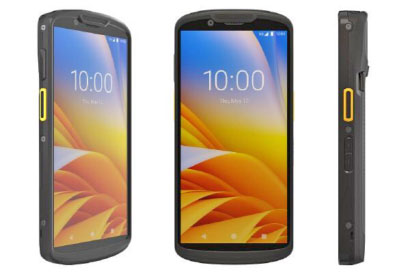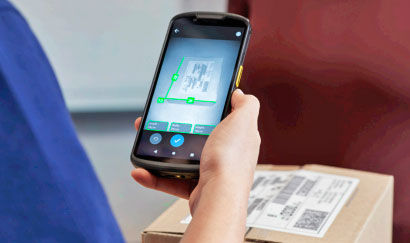|
Zebra TC53/TC58 Mobile Computer
Big step forward in performance and functionality of Zebra's TC5x enterprise mobile computer platform
(by Conrad H. Blickenstorfer)
Share on:



On May 4, 2022, Zebra Technologies Corporation introduced a new generation of the Zebra TC5X series mobile computers, designed, as Zebra states, "to do more with new hardware and software innovations that redefine mobile computing performance." If that sounds like a gentle swipe at the industry-common practice of just upgrading the electronics of existing designs, that may be so. For the TC53/TC58 platform — the TC58 with WWAN, the TC53 without — isn't a reboot. It's entirely new and a big step forward.

So what does the new TC53/TC58 bring over the predecessor TC52/TC57 and the original TC5 Series? While they are all quite rugged, this latest duo looks like a modern smartphone more than ever. With billions of modern smartphones out there that's a good thing. The TC53/TC57 feels and handles just like what everyone is already used to. The new models' footprint is also just like a modern smartphone, and unlike the often smaller screens of competing devices, the TC53 and TC58 have nice, big 6-inch screens with super-sharp 1080 x 2160 402 pixel per inch resolution in a 2:1 aspect ratio. All of this undoubtedly contributes to user adoption and productivity with the devices.
The tech, of course, is much more advanced as well. The Snapdragon 660 octa-core processor of the older TC52/TC57 was (and still is) sort of a vertical market industry standard, but the Qualcomm 6490 takes performance to another level. This System-on-Chip was specifically designed for enterprise and IoT applications, including support for global 5G and Wi-Fi 6E and a whole bunch of other tricks. Check the table below to see how the TC53/TC57 compares to the older duo:
|
Model
|
TC53/58
|
TC52/57
|
|
Introduced
|
2022
|
2018
|
|
OS
|
Android 11, upgradeable to 14
|
Android 8.1
|
|
Processor
|
Qualcomm 6490
|
Qualcomm SD660
|
|
Cores
|
8 x Kryo 670
|
8 x Kryo 260
|
|
Clock speed
|
up to 2.7GHz
|
up to 2.2GHz
|
|
GPU
|
Adreno 643
|
Adreno 512
|
|
RAM/Flash
|
4-8GB/64-128GB
|
4GB/32GB
|
|
Expansion slots
|
micro SD/SDHC/SDXC up to 2TB
|
micro SD/SDHC/SDXC up to 256GB
|
|
SIM slots
|
TC58: 1 x nanoSIM, 1 x eSIM
|
TC58: 1 x nanoSIM, 1 x eSIM
|
|
Display type
|
Optically bonded TFT LCD, 600 nits, Gorilla Glass 5
|
Optically bonded TFT LCD, ??? nits, Gorilla Glass
|
|
Display
|
6.0"/1080 x 2160 pixel (402 dpi)
|
5.0"/720 x 1280 pixel (294ppi)
|
|
Digitizer
|
Capacitive stylus/bare/glove
|
Capacitive stylus/bare/glove
|
|
Battery
|
17.7 watt-hour Li-Ion
|
15.5 watt-hour Li-Ion
|
|
Size (inches)
|
6.5 x 3.04 x 0.66
|
6.1 x 2.9 x 0.73
|
|
Weight (oz.)
|
10.3
|
8.8
|
|
Sealing
|
IP65 and IP68
|
IP65 and IP68
|
|
Temp. range
|
-4° to 122°
|
-4° to 122°
|
|
Tumbles
|
1000 x 0.5m
|
500 x 0.5m
|
|
Drops
|
5-feet 810H
|
4-feet 810G
|
|
Camera
|
front: 8mp; rear 16mp
|
front: 5mp; rear 13mp
|
|
USB
|
1 x USB Type-C 1 x USB 2.0 Host
|
1 x USB 2.0 HOST + Client
|
|
Bluetooth
|
5.2
|
5.0 BLE
|
|
WiFi
|
802.11a/n/ac/ax
|
802.11 a/b/g/n/ac/d/h/i/r/k/v3/w
|
|
WWAN
|
TC58 only: 5G
|
TC57 only: GSM/GPRS/EDGE, 4G LTE
|
|
Scanning
|
SE4720 or extended range SE55
|
SE4720
|
There is a new and much more powerful graphic processor, and the cameras are greatly improved as well. The front camera goes from 5 to 8 megapixel, and the rear camera from 13 to 16 megapixel. Thanks to the immense popularity of smartphones, smartphone cameras have improved in leaps and bounds, and industrial mobile computers like the TC53/TC58 benefit from that.
Note that Zebra offers base and premium versions of the platform and the latter ups the ante in the camera department with optical image stabilization and a special type of "Time of Flight" distance sensor. This can be used with Zebra Dimensioning applications such as Certified Mobile Parcel, the first internal weights and measures certified fully integrated mobile dimensioning solution, as well as Mobile Parcel that allows for quick and accurate parcel dimensions wherever that streamlines operations.

One important thing that sets mobile computers such as the Zebra TC53/TC58 apart from even the most advanced smartphones is their industrial-grade scanning capabilities. Sure, anyone can scan barcodes with a smartphone camera and a scanner app, but that's slow and cumbersome. On the job one needs an integrated dedicated scanner, something Zebra managed to build into the TC53/TC58 that's only 2/3 of an inch thick.
But that's not all. With this new platform, customers can not only opt for the popular Zebra SE4720 (an improved version of the SE4710 that came with the predecessor TC52/TC57), but also for the Advanced Range Zebra SE55 with four times the imager resolution that lets you scan from as close as the SE4720 with most codes, but also from three times as far away as with the SE4720. Another plus for productivity.
For storage it's no longer one size fits all as it was with the TC52/TC57; the new models are available with 4GB or 8GB of RAM and with 64GB or 128GB of Flash. This not only accommodates the much quicker processor, but also lets customers select a version that fits their needs. More RAM and storage also comes in handy when using a TC53 or TC58 with the optional Workstation cradle where you can connect to a big screen, keyboard, mouse, printer, etc, for a complete desktop or Point-of-Sale solution.
And since many prospective TC53/TC58 customers will use their devices for voice communication in noisy areas, there's not only standard phone functionality (TC58), but also push-to-talk capability, three microphones, a strong speaker, and noise cancellation. Even full PBX handset functionality is available via Zebra's Workforce Connect Voice.
Android didn't start out as a natural to meet enterprise requirements, and it's been a massive task to patch Google's ever-changing phone OS into something enterprises feel comfortable with. Zebra, which by now has a almost a full decade's worth of experience in adapting Android to the enterprise, has done a great job with providing features, utilities and functionality suitable for the enterprise. This was initially done with layers of "Android Mx" extensions and has now morphed into Zebra's "Mobility DNA".
Built to last
While the front-line workers in retail, postal/courier and field service deployments that Zebra has in mind with the TC53/TC58 aren't generally seeing environmentally extreme working environments, the company made sure the devices are easily capable of handling most adverse situations they may encounter.
TC53/TC58 handhelds can survive five-foot drops to concrete. That's a foot more than the older TC53/TC57, which is important because handhelds used as phones may fall from five feet or more (where the optional rugged booth comes in) during a call. The new platform has now been tested to survive 1,000 tumbles rather than just 500 like the older versions. The -4 to 122 degree Fahrenheit operating temperature range is wide enough for all intended applications, including commercial freezers. Sealing is listed as "IP65 and IP68." We're not sure what Zebra means here as IP68 is fully waterproof and IP65 isn't.
Zebra TC53/TC58 Series: Truly the next generation of Enterprise Android devices
With the TC53 and the mobile broadband-equipped but otherwise largely identical TC58, Zebra has smartly redesigned and reengineered their TC5X Series of rugged mobile computers. It's a reboot that not only (substantially) enhances hardware performance, communication, functionality and ease-of-use, but also addresses OS software with the current version of Android, an upgrade guarantee for the next three Android revs, and an expanded array of workforce productivity, security, management and connectivity enhancements. And, of course, the devices seamlessly fit into Zebra's vast array of mobile printing and logistics solutions. -- Conrad H. Blickenstorfer, May 2022
|



